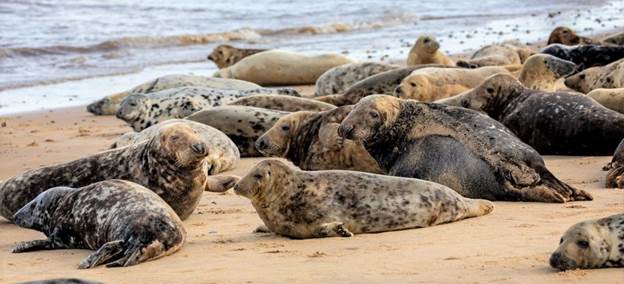
A wild grey seal colony on the beach at Horsey, UK. Photo courtesy of Nigel
As the COVID-19 pandemic sweeps across the globe, people are beginning to understand, at a very personal level, the ways in which infectious diseases can devastate human life. But a team from Virginia Tech is conducting research on another form of mass mortality events: Those that affect marine mammals.
In 2000, over 10,000 endangered Caspian seals died in less than a four-month span. Researchers later discovered that the culprit behind this devastating mass mortality event was canine distemper virus.
Infectious disease-induced mass mortality events are known to afflict a variety of species, including invertebrates, birds, fish, and both land and aquatic mammals. However, these events in aquatic mammals are understudied compared to their land-dwelling counterparts.
“We are perhaps more alert than ever to the catastrophic impacts of infectious disease in both humans and animals. Our task now is to begin to understand what drives these events, particularly in species like marine mammals, where our knowledge is even more limited,” said Claire Sanderson, a research associate in VT’s Department of Fish and Wildlife Conservation within the College of Natural Resources and Environment
To help fill in the knowledge gaps, Sanderson worked with Kathleen Alexander, a professor in the Department of Fish and Wildlife Conservation, to evaluate the factors influencing the occurrence of these events in marine mammals. They published their findings in Global Change Biology.
Sanderson and Alexander defined a mass mortality event as a “devastating number of fatalities within the same species over a brief period of time,” which is also dependent on the species’ conservation status and population size. Beyond the deaths of individual animals, mass mortality events can initiate a cascade of events with severe ecological repercussions. Affected populations are often at a greater risk of local extinction, and changes in community structure can upset an ecosystem’s balance.
By conducting extensive literature searches, Sanderson and Alexander discovered that infectious disease-induced mass mortality events occurred in 14 percent of marine mammal species between 1955 and 2018. Viruses were responsible for 72 percent of these events and caused 20 times the number of deaths than bacterial outbreaks.
Their research revealed that environmental variables — such as season and sea surface temperature anomalies — were significantly associated with disease outbreaks in marine mammals.
One of the most indicative measures of climate change is fluctuating sea surface temperatures. Sanderson and Alexander found that 61 percent of mass mortality events in marine mammals occurred during periods in which regional sea surface temperature anomalies occurred. The study suggested that the incident rate of an infectious disease-induced mass mortality event increases by nearly 12 percent for “every unit increase in global sea surface temperature anomalies.”
“As climate change intensifies, this may set off a complex chain of events that dramatically alter these ecosystems, affecting marine populations living in these environments,” said Alexander. Climate change effects on sea ice and ocean salinity also have implications for the spread of disease.”
“Marine mammals represent important sentinels of aquatic health by providing information essential for managing threats to these vulnerable ecosystems,” said Sanderson. “Addressing the root causes of climate change will be of critical importance as we chart a path forward in managing these species.”
Of all the marine mammal species that suffered an infectious disease-induced mass mortality event, the study found that 37 percent were listed as endangered or vulnerable to extinction.
“This work underscores the critical threat infectious disease can pose to marine species and the potential importance of climate change as a wide reaching driver of this process,” Alexander said. “Here, our role is complex as we contribute directly to our changing climate, increasing pathogen pollution, and habitat degradation. But we also have the power to change things, address climate change, protect species and environments through effort and innovation — humanity at its best,” Alexander said.


